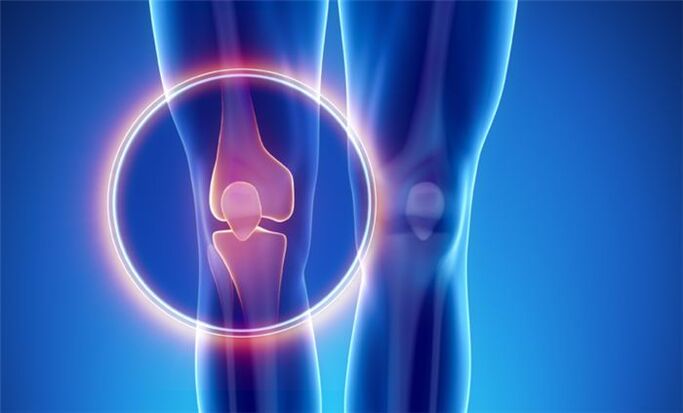
Arthrosis of the joints is a chronic disease of the joints that occurs due to metabolic disorders. As a result, degenerative, dystrophic changes and destruction of cartilage tissue occur.
It occurs imperceptibly, but often develops very quickly. A person begins to feel pain in the joints when moving, there is stiffness and reduced mobility, especially in the morning, and it is still "not in opposition". If discomfort appears and periodic pain occurs during unpleasant movements or loads, then it is very important to understand that it will not go away, and without intervention the situation will only worsen.
Symptoms of arthrosis
Arthrosis of large and medium joints seriously changes a person's lifestyle, worsens the quality and imposes restrictions. The development of the disease is like an avalanche and the treatment is most often associated with unbearable pain, which is a clear sign of wear and tear of the joints.
The symptoms of arthrosis of the joints depend on how much the joint, cartilage tissue and nearby tissues are affected.
In the initial stages, arthrosis can be determined quite precisely, the treatment in this case is sparing and does not require serious interventions and expensive drugs for the treatment of arthrosis.
Types of arthrosis
Arthrosis of the joints is classified according to several criteria. Depending on the degree of arthrosis changes in the cartilage tissue, there are 4 stages of arthrosis. Arthrosis is also divided into primary and secondary. The cause of the development of primary arthrosis is age-related changes. Secondary arthrosis occurs due to joint injuries and diseases (for example, traumatic arthrosis or rheumatoid arthritis). The disease can also develop slowly over years or lead to joint destruction in just a few years (progressive osteoarthritis).
There is alsoTypes of arthrosis depending on the affected area:
- - arthrosis of the knee joint - arthrosis of the hip joint
- Uncovertebral arthrosis - arthrosis of the cervical vertebrae
- Vertebral arthrosis - damage to the spine
- Patellofemoral arthrosis is a type of gonarthrosis that affects the patella and part of the femur.
The degree of the disease is determined by the degree of cartilage tissue damage.
Arthrosis of the 1st degree - cartilage tissue is slightly damaged, the person does not feel discomfort;
II degree arthrosis - osteophytes appear, the space between the cartilages decreases, situational pain occurs with uncomfortable movements;
III degree arthrosis - the cartilage tissue is partially destroyed and exposes the bone tissue, the gap between the cartilages decreases, the pain is frequent and severe;
IV degree arthrosis - a significant part of the cartilage tissue is destroyed up to 60%, there is no space between the bones, patients experience constant, severe pain, hyperthermia of the area above the joint occurs.

- Characteristic creaking during movement and a slight aching pain in the back;
- Limitation of joint mobility, discomfort during full physical activity;
- "Jumping" blood pressure indicators;
- Headache and dizziness;
- Convulsive syndrome and often muscle spasms;
- Visually observed joint deformity;
- Swelling, hyperthermia or redness of the skin area above the affected joint;
- Violation of motor function.
Why the disease appears
Arthrosis of the joints can manifest itself in any department, but most often patients turn when they feel arthrosis of the knee or hip joint. In the professional field, with a special, specific load on the hands, shoulder arthrosis can be observed.
Lesions differ in men and women.The strong half often suffers from temporomandibular, joint, ankle and lumbar arthrosis. Women complain more about the thoracic and cervical region, as well as the joints of the fingers and toes.
The type of disease is determined by the location of the lesion. There are the following types:
- arthrosis of the hip joint - coxarthrosis;
- arthrosis of the knee joint - gonarthrosis;
- damage to the patella and part of the femur - patellofemoral arthrosis (a type of gonarthrosis);
- diseases of the spine - vertebral arthrosis;
- damage to the cervical spine - uncovertebral arthrosis.
The main reasons are:
- inflammatory process;
- professional sports;
- overweight;
- professional non-standard load, for example, squatting or kneeling;
- previous joint injuries (post-traumatic);
- hypothermia;
- heredity;
- age changes.
Arthrosis can appear as an independent disease, or it can be the result of an already ongoing disease, so it is important to know a person's history.
Diagnosis of arthrosis of the joints
Arthrosis of the joints is detected by X-ray. The X-ray shows how the joint is deformed and how narrow the joint space is. It may also be necessary to undergo MRI or arthroscopy, but only in particularly complex and ambiguous cases. Usually, x-rays of the joints are sufficient to diagnose the disease.

In order to understand the presence of the disease, its severity, as well as which disorders led to the disease, a comprehensive diagnosis is carried out.
First, with helpx-ray image in different projectionsget information about the degree of joint damage.
Tomography (magnetic resonance or computed tomography) helpsrule out tumor processes.
Third, you shoulddo the teststo understand whether arthrosis is an independent disease or a complication, as well as to determine the general condition of the person.
The complex of studies is the most informative and gives a clear idea of degenerative-dystrophic changes and helps in choosing the optimal treatment plan.
Treatment of arthrosis
As explained above, osteoarthritis can develop due to many factors, and a treatment plan is developed based on understanding the underlying causes and the medications to treat osteoarthritis are selected accordingly.
Treatment should be developed individually, based on the results of the diagnosis. Be sure to take into account the person's condition, his existing diseases.
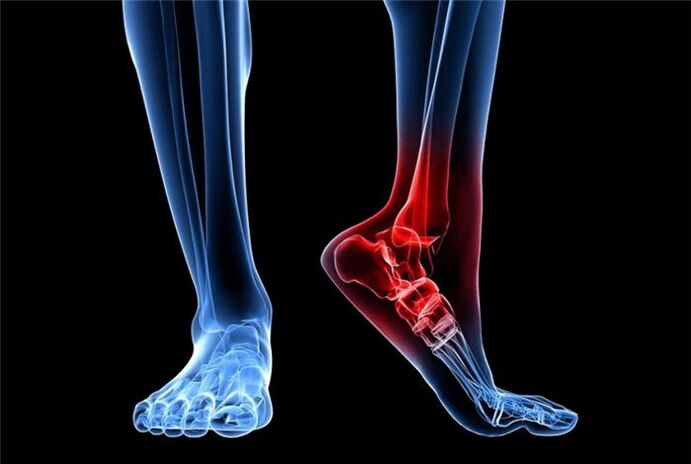
Restoration of the joint surface and cartilage tissue is not fast. Effective drugs that have side effects are prescribed. And taking medication to achieve the desired result takes up to 6 months, so it is important to protect your health from side effects as much as possible.
Medical treatment of arthrosis
The main goal of such therapy is to eliminate the manifestations of arthrosis. Treatment of arthrosis of the joints with drugs includes:
- Nonsteroidal anti-inflammatory drugs. With arthrosis, a person feels pain, the joint becomes inflamed. This group of drugs is prescribed to eliminate unpleasant symptoms and stop inflammation.
- Hormonal injections into the joint. Corticosteroid drugs are most often used in the acute phase of arthrosis.
- Chondroprotectors. The main task of these drugs is to stop the degenerative processes in the cartilage tissue in order to prevent its further destruction.
- Intra-articular injections of hyaluronic acid. Hyaluronic acid preparations are similar to synovial fluid, which allows gliding and smooth free movements in the joint. In arthrosis, the synovial fluid is not secreted enough, so orthopedists often prescribe injections of hyaluronic acid (joint injections in arthrosis).
- Biological therapy of arthrosis (PRP and cytokine therapy). A new innovative method of arthrosis therapy that has recently entered practice, but is becoming more and more popular. It is about the application of medicines based on the patient's blood plasma enriched with platelets. Thanks to biological therapy, the blood flow to the joint is activated, the production of intra-articular fluid is activated, and the cartilage tissue is supplied with nutrients.
Important!Treatment of arthrosis with drugs is effective in the early stages of the disease. Also, experts emphasize that drug therapy is not able to restore the damaged joint, but it will enable the elimination of symptoms and slow down the progression of arthrosis.
Physiotherapy and other conservative treatments for arthrosis
In the fight against arthrosis, physiotherapy is also used. Different procedures (laser, phonophoresis, electrophoresis, magnetotherapy, UVT) and exercise therapy are prescribed to improve metabolic processes and blood circulation, strengthen muscles.
In addition, with arthrosis, you just need to make some adjustments to your lifestyle:
- Avoid overexertion – it's important to evenly space the activity and take breaks to avoid overexerting the joint
- Take care of your diet and watch your weight - since excess weight only worsens the joint problem, you need to review your diet and reduce your body weight
- Remember to be careful and avoid injury as much as possible
- Use additional support for movement - in the later stages of arthrosis, independent movement becomes questionable, so you must use a cane or crutches. For more comfortable walking, you can also use orthopedic insoles - they will reduce the load on the joint.
There are also many folk recipes that "will help in the fight against arthrosis". However, treatment of arthrosis at home also does not always bring results. Moreover, the use of all kinds of self-made lotions and ointments usually only causes allergic reactions and does not affect the health of the joint.
Surgical treatment of osteoarthritis
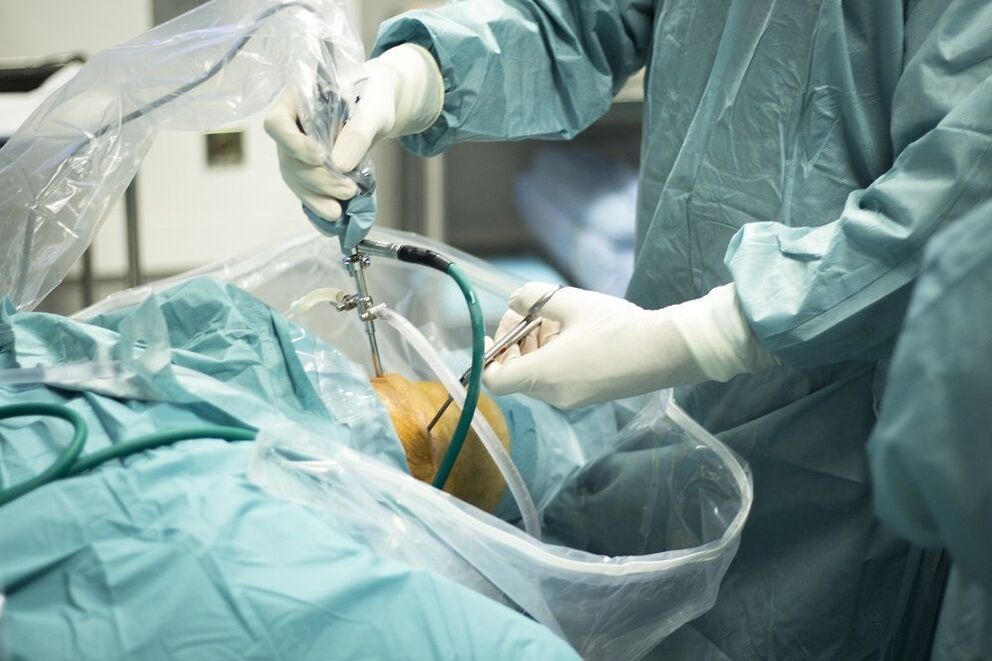
How to treat arthrosis if all the above methods do not work? In that case, surgical treatment of osteoarthritis is prescribed. Depending on the degree of damage to the joint, the individual characteristics of each patient, the type of operation is selected.
Arthroscopy of the joint is a low-traumatic intervention, an intra-articular operation through several micropunctures in the joint. In arthrosis, it is used as a temporary measure for "cleaning the joint": removing parts of the cartilage, osteophytic growths that interfere with free movement. Such treatment reduces pain in the joint, but it is not a solution to the problem of arthrosis.
Osteotomy is an operation to align the joint axis. The fact is that with arthrosis, as a rule, one part of the joint suffers more (has a large load). As a result of the osteotomy, the load on the joint is redistributed. It should be noted that arthrosis is a progressive joint disease. Therefore, osteotomy is a way to delay further treatment, but not to avoid it.
Joint arthroplasty is an effective, and in some cases, the only method of treating arthrosis of the joints. The essence of the operation is the removal of the joint destroyed by the disease and the installation of an artificial endoprosthesis in its place. The artificial joint is chosen individually, ideal for each patient and completely restores the functions of the damaged joint after a period of rehabilitation.
Contraindications for arthrosis
What you should pay attention to in arthrosis of the joints:
Joint loads- with arthrosis, you must abandon weight lifting, excessive static loads. A stick can be used to relieve the joint. Shoes – Properly fitted shoes reduce the strain on the joint. It is recommended to avoid high-heeled shoes.
Weight- excess weight is another factor in the progression of arthrosis. Therefore, it is important to maintain a healthy weight and eat a balanced diet.
Sportsshould also be revised. With arthrosis, it is necessary to exclude sharp jerky movements (contact sports, wrestling), running long distances, lifting weights. But this does not mean that physical activity should be stopped completely. Moderate activity will only benefit the joint.
In addition to medical treatment, physiotherapy is actively used. These are magnetotherapy, electrotherapy, thermotherapy. In addition, physiotherapy exercises are recommended to strengthen the muscles around the affected joint and improve blood supply.
A radical method of deforming arthrosis, which has led to deterioration of the quality of life, is often surgical intervention. In that case, either arthroscopy or arthroplasty is performed.
Arthroscopy is a procedure in which the worn upper layer of the joint is removed and a partial prosthesis is placed in its place. This allows you to get rid of pain and regain mobility.
Endoprosthetics is the replacement of a joint with a prosthesis. It is suitable for severe destruction, when there is no point in saving the joint itself. The prosthesis has artificial cartilage, which anatomically fully corresponds to human cartilage.
Treatment of the disease in the initial stage is the provision of quality cartilage tissue nutrition. For this purpose, the use of chondroprotectors, preferably of natural origin, flavonoids is recommended. Motor load is also necessary to improve blood supply to bones and perichondrium.
Deforming arthrosis of the knee
Deforming arthrosis of the knee joint(gonarthrosis, DAK) is a chronic progressive disease of articular cartilage. It is characterized by the destruction of joint structures, which is accompanied by pain, inflammation and characteristic curvature of the extremities ("wheel legs" or X-shaped deformation).
Causes of deforming arthrosis of the knee
Without proper lubrication, the joint "dries up", cracks and loses height, exposing the heads of the bones. In this case, the plate to close the articular surface of the bone remains helpless; repeated irritation of the numerous nerve endings located in it causes pain and discomfort.
The following factors or their combination can become the cause of deforming arthrosis of the knee:
- the presence of joint disease (especially knee disease) in relatives;
- genetic disorders associated with the formation of abnormal, unstable cartilage cells or their accelerated death;
- congenital and acquired malformations of the musculoskeletal system (flat feet, joint hypermobility, dysplasia, scoliosis, kyphosis, etc. );
- excessive professional, domestic or sports loads;
- microtraumas and injuries of the knee joint and meniscus, operations on it, leg fractures;
- circulatory disorders (varicose veins, atherosclerosis, thrombosis and other vascular diseases), their consequences (dissecting osteochondritis), as well as other causes of prolonged leg cramps;
- inflammatory diseases of the joints and periarticular tissue (synovitis, bursitis, tendinitis, arthritis), incl. autoimmune nature (rheumatoid, psoriatic arthritis);
- metabolic disorders (gout, diabetes mellitus);
- joint aging processes and age-related leaching of calcium from bones;
- hormonal disorders and changes in the hormonal background (for example, associated with estrogen deficiency in women);
- hypovitaminosis;
- overweight (observed in ⅔ patients);
- physical inactivity.
But the main reason why deforming arthrosis of the knee is so common lies in its structure. The knee joint has only one axis (plane) of movement. Therefore, the range of permitted movements is very limited. One awkward turn can injure the periarticular tissue and cause arthritic changes - after all, the painful knee will be exposed to daily stress.
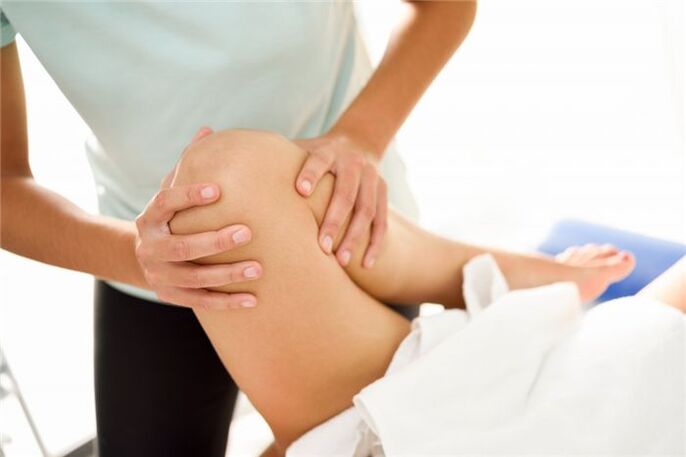
Symptoms of deforming arthrosis of the knee joint
Gradually intensifying pain in the area of the knee joint. At first, the pain is noticeable only when moving - for example, when sharply straightening or bending the leg, there is a feeling that "unfortunately, he stepped on the foot. "In the early stages, the pain may be episodic or so mild that it is perceived as discomfort. Then the pain intensifies after physical exertion or prolonged stay in the same position. The skin also becomes painful - it reacts sensitively to every touch, incl. and clothes.
There are 3 types of specific pain in deforming arthrosis of the knee joint:
- onset (lasts 15-30 minutes after the joint comes out of a long resting state);
- mechanical (sensitive during physical activity and disappears after rest);
- blockage (sensation of a sharp pinch in the knee).
Symptoms of deforming arthrosis of the knee, as a rule, grow slowly due to the fact that the disease is not characterized by rapid progress. This is the insidiousness of arthrosis - gradually getting used to the discomfort of the disease, the patient "gets used" to the pain, does not notice the deterioration and postpones the visit to the doctor.
Treatment of deforming arthrosis of the knee joint
The treatment of deforming arthrosis of the knee joint consists of the complex application of drugs, dosed loading of the joint, physiotherapy procedures and the use of orthopedic aids.
In the treatment process, alternating loading and unloading is extremely important, in order to prevent static loading of the knee. Orthopedic insoles, specialized shoes, canes, crutches, walkers, ergonomic chairs for work and rest also help to slow down the disease. Orthoses with variable stiffening, which enable modeling of the physiological axis of the leg and compensation of deformities, are particularly effective.
In the early stages of deforming arthrosis of the knee, the goal of treatment is to restore the destroyed joint and ligament apparatus, relieve pain and increase the range of voluntary movements. In the later - in alleviating the patient's condition. For this, remedial arthroscopy (washing with an antiseptic) is performed when a piece of osteophyte breaks off, corrective osteotomy (correction of a curved bone), endoprosthetics (replacement) of the joint.
In addition to orthopedists, physiotherapists and chiropractors, exercise and therapeutic massage specialists, and surgeons will tell you how to treat deforming arthrosis of the knee joint.
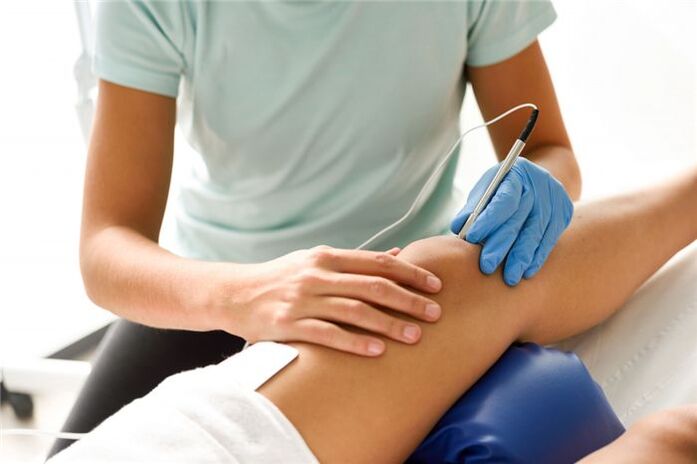
Physiotherapy
Among other physiotherapeutic methods for the treatment of deforming arthrosis of the knee joint, the following are used:
- laser and magnetotherapy;
- microwave therapy;
- shock wave therapy;
- amplipulse;
- ultrasound therapy;
- electrophoresis with analgin, novocaine, chymotrypsin, etc. ;
- phonophoresis with glucocorticoids;
- applications of paraffin and ozokerite;
- cryotherapy;
- acupuncture;
- joint traction and kinesitherapy;
- balneotherapy.
Massage for deforming arthrosis of the knee joint
Therapeutic and lymphatic drainage massage for deforming arthrosis of the knee joint, as well as manual therapy, is performed by a specialist after removing inflammation in the joint. For self-massage at home, stroking and rubbing, as well as movements for stretching muscles and ligaments, deep warming up (performed last, after the warming effect) are recommended. Self-massage goes well with local irritants and essential oils. Remember that with deforming arthrosis of the knee joint, massage is performed on both joints, even if only one of them is affected.
Exercises for deforming arthrosis of the knee joints
Therapeutic gymnastics (exercise therapy) for deforming osteoarthritis of the knee joint is performed in a sitting or lying position, water aerobics is also effective. An individual set of exercises for deforming osteoarthritis of the knee joint is compiled by the instructor. In the following, we offer a short warm-up in order to strengthen the leg muscles.
- Sit on the floor, legs straight, emphasis on the hands behind the back. Bend and separate the toes.
- The initial position is the same, slowly bend the leg, at the end of the movement rest the toe on the floor. Repeat with the leg behind the other leg.
- Continue in the same starting position, lift the outstretched leg in front of you, toe towards you.
- Without changing the starting position, we pull our hands to the toes of our straight legs.
- Sitting on the floor, hug the bent knee and try to raise the other leg above the floor.
- Sitting on the floor, spread your legs shoulder-width apart. Turn your legs alternately so that the toe moves 180 degrees.
- Sitting on the floor, legs bent. Turn your foot from heel to heel, feeling the work in the back of your thighs.
Excellent! Perform knee osteoarthritis deformation exercises at least 3-6 times a day.
Medicines for deforming arthrosis of the knee
Treatment of deforming arthrosis of the knee joint with drugs enables a quick stop of acute pain, reduction of inflammation and swelling, and improvement of nutrition of the joint. Therefore, drugs are used in all stages of the disease and help restore knee mobility.
Chondroprotectors
For the regeneration and maintenance of synovial cartilage, chondroprotectors are used in the form of tablets, capsules, bags and injections.
Anti-inflammatory
Steroidal and nonsteroidal anti-inflammatory drugs are used to treat deforming arthrosis of the knee joint. They are prescribed in the form of tablets, injections, sachets, creams, ointments and other products for external and internal use.
Anti-inflammatory drugs can be used together with anesthetics, which are injected into the joint cavity as a block.
Antispasmodics
Removal of the spasm is necessary in order for the patient to return to normal activities and the normal supply of nutrients to the tissues.
Angioprotectors
For deforming arthrosis of the knee joint, preparations based on horse chestnut and others are used.
Heating means
Among the means for heating, it is worth highlighting preparations based on natural ingredients: snake and bee venom, hot pepper, mustard.
All these drugs improve blood supply to the tissues and prevent pain.
Nutrition for deforming knee arthrosis
A healthy diet for deforming osteoarthritis of the knee joint includes meals with a reduced content of trans fats and "fast" carbohydrates. Preference should be given to lean meat and fish, seafood and vegetables, steamed, wrapped in foil or stewed under the lid. Fruits, berries and drinks rich in antioxidants are also useful - wild herbs, blueberries, cranberries, cranberries, high-quality green tea and coffee. You can also eat whole grains, legumes.
But potatoes, white bread, sweets, ready-made food, fast food and alcohol should be excluded.
If you are overweight with deforming osteoarthritis of the knee, consider low-carb diet options.

























